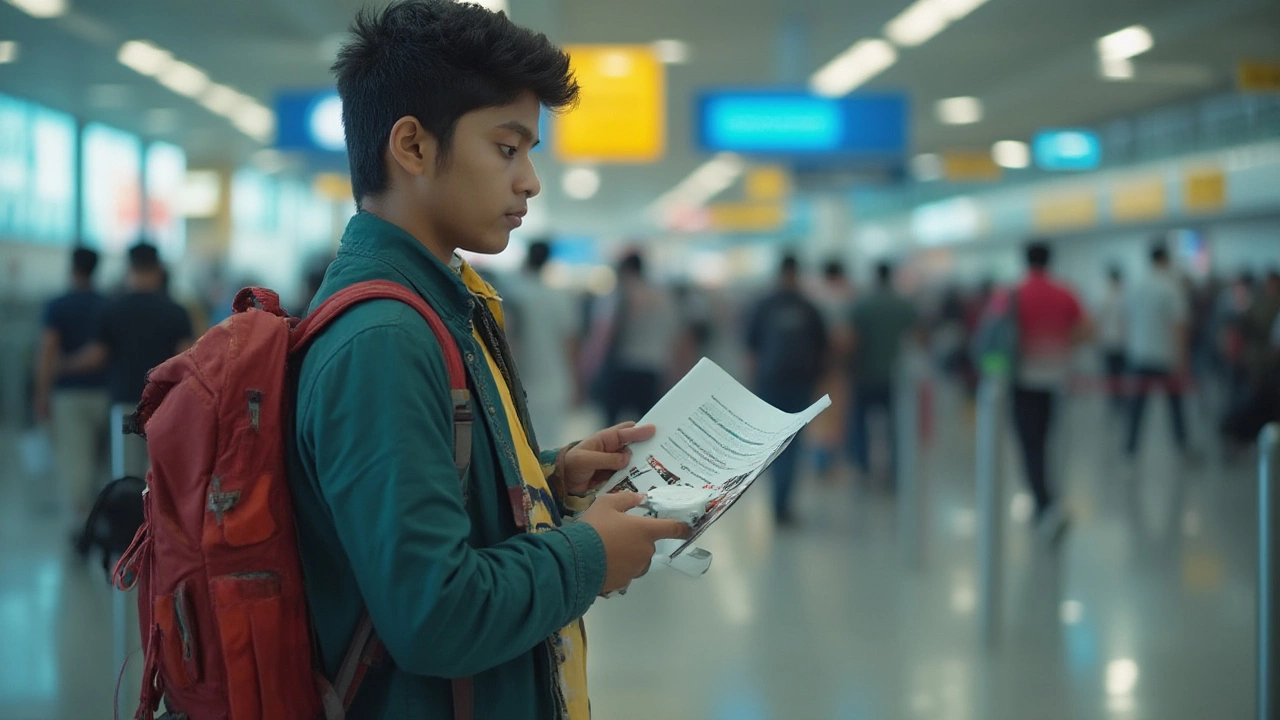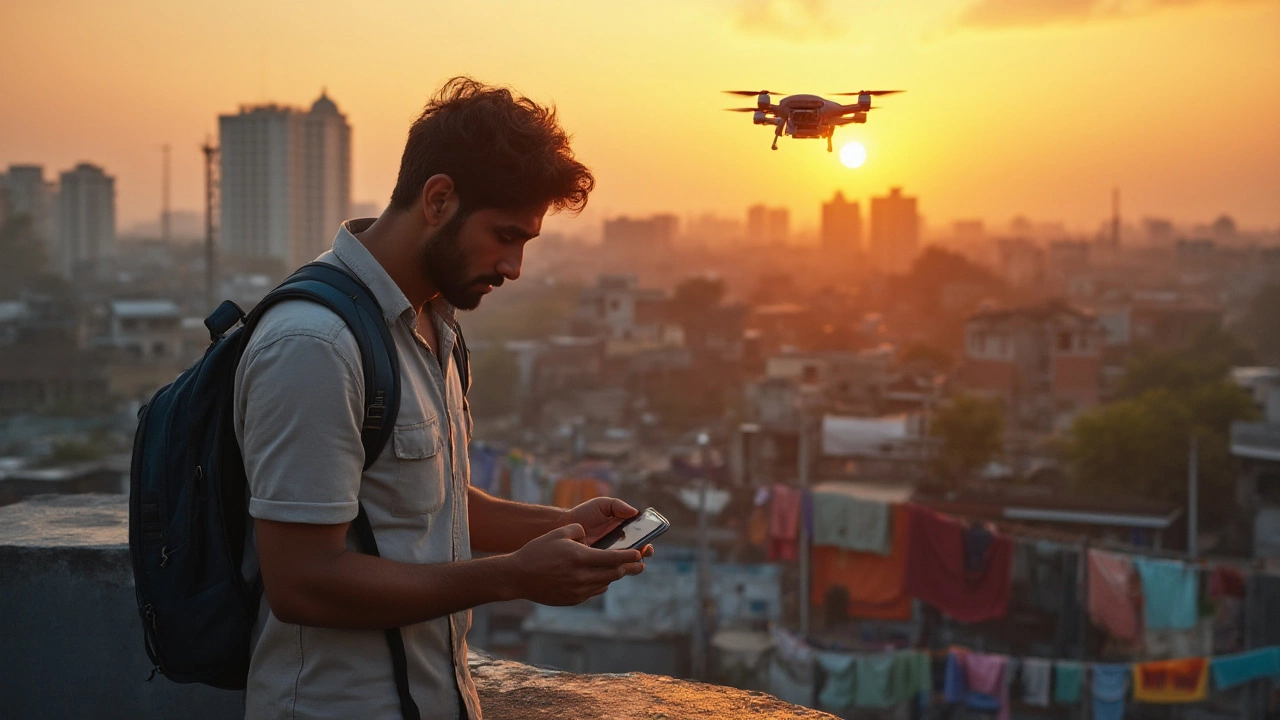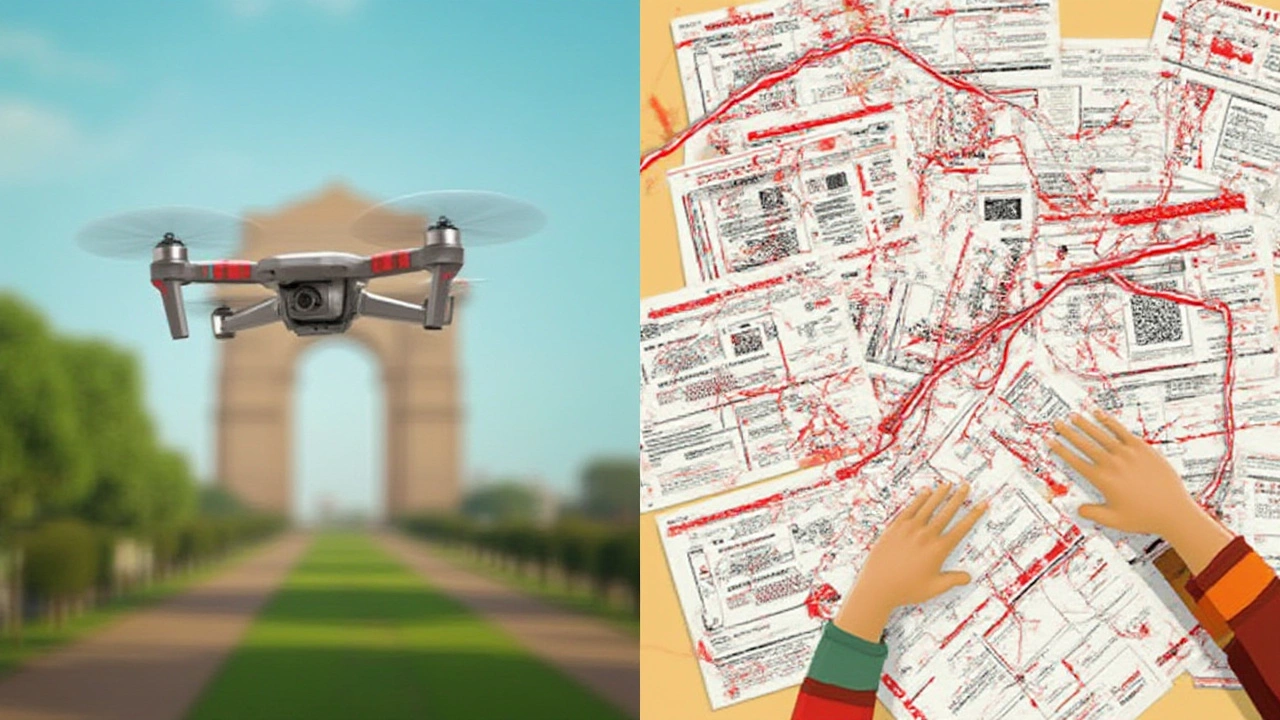Is the DJI Mini 2 Legal to Fly in India? Rules, Registration, and Tips in 2025
 Jul, 8 2025
Jul, 8 2025
If you’re traveling to India, packing your drone feels like stuffing a bit of freedom into your bag. But landing with a DJI Mini 2 isn’t as simple as tossing it in your carry-on. Indian skies may look inviting, but the rules for drones are strict—and they catch a lot of people off guard. Get this: you could have your drone seized at customs, or be slapped with a fine if you just launch it anywhere. If you want to avoid headaches, keep reading—some of the rules in India feel almost hidden unless you dig deep.
DJI Mini 2: Why It’s a Popular Choice and Where It Stands in India
The DJI Mini 2 has won hearts for being feather-light, folding into practically nothing, and shooting buttery 4K video. Weighing only 249 grams, it ducks under many strict rules worldwide—heck, even here in the UK, it’s almost hassle-free. But here’s the curveball: in India, the Mini 2’s tiny size isn’t enough to side-step bureaucracy. Since 2021, India’s Ministry of Civil Aviation released the Drone Rules, which treat almost all foreign-made drones the same, regardless of size. Drone fever is catching, but India’s skies need a lot of paperwork for non-local tech.
Most tech lovers assume under-250g drones are fair game. Not in India. The catch is that the Mini 2 (and nearly every imported drone) falls under “non-Nano” if it has a camera and isn’t Indian-made. Yes, you read that right. To fly it legally, you need to register it and get a Unique Identification Number (UIN) from the Digital Sky Platform. But here’s the kick: as of July 2025, the Mini 2 isn’t natively listed for import clearance. Unless you bought a drone inside India from an authorised dealer, importing it yourself is tough—if not impossible, officially.
India’s Drone Rules in Plain English: Not for the Faint-Hearted
India’s drone rules changed a lot in the last few years. It used to be a bureaucratic maze, and now? It’s still tricky. Any drone above 250 grams–which the Mini 2 is just under–is usually called a "Nano" and treated with fewer restrictions. But since the Mini 2 comes with a camera and isn’t made in India, it slides into “Micro” or higher, needing Digi Sky clearance and a serial number. There’s no loophole that lets foreigners glide past the process.
Here’s what the rulebook says for flying in India (as of July 2025):
- Register your drone on India’s Digital Sky Platform and get a UIN (Unique Identification Number).
- You’ll need to buy insurance for your machine — no ifs or buts.
- Foreign nationals can’t register drones directly. Only Indian entities or citizens get that privilege.
- Importing drones is tightly controlled. Customs regularly seize drones brought in by visitors. You need an import clearance from DGCA and the DGFT–rarely granted to hobbyists.
- No-fly zones sprawl across India: no drones near airports, government buildings, military zones, or sensitive heritage areas.
- If you’re dreaming of those sunrise shots at the Taj Mahal—don’t. Protected monuments and national parks are all banned for drones without strict government permission.
- Your drone must stay below 120 meters (400 feet) and always within line of sight.
- Flying after dark is illegal unless you have special permission, which is nearly impossible to secure as a visitor.
If you’ve got visions of quick and easy flying, the Indian drone scene will feel like a bucket of cold water.

Can You Import or Fly DJI Mini 2 as a Tourist?
This one pulls the rug from most travelers. You can’t just stroll into India, unpack your DJI Mini 2, and zoom around like it’s a free-for-all. Customs are on high alert: imported, unregistered drones usually get confiscated on arrival. Even “duty paid” does not equal “cleared to fly.”
If you found a Mini 2 in an Indian shop, take a breath: only drones approved by the Digital Sky list can be registered and flown. Most shops sell Indian-made or fully certified models—foreign drones often get stonewalled. The loophole of slipstreaming a foreign drone through a local friend? Also tricky. The registration has to be in an Indian citizen’s name, and linking it to Digital Sky means putting your ID on record. Anyone caught flying an unregistered drone faces fines, confiscation, and possibly more if they wandered near sensitive places.
For journalists or filmmakers, process gets more thorny: you’d need special, time-limited permissions, which only production companies with a local office tend to get. Everyday tourists don’t get any slack.
Here’s an example table, showing just how the rules look for the Mini 2:
| Requirement | DJI Mini 2 (India) | DJI Mini 2 (UK) |
|---|---|---|
| Import Allowed? | No (unless approved on Digi Sky) | Yes |
| Mandatory Registration? | Yes (needs UIN, not available for foreign tourists) | No (below 250g, basic rules apply) |
| Insurance Needed? | Yes | No (register if flying commercially) |
| Flight Altitude Limit | 120m / 400ft | 120m / 400ft |
| Always Visual Line of Sight? | Yes | Yes |
| Where You Can’t Fly? | No-fly zones, crowds, heritage sites, military areas | No-fly zones, airports, sensitive areas |
The bottom line: unless you’re an Indian citizen, importing or registering a DJI Mini 2 India will have you tangled in red tape.
Tips and Real-World Experiences: Getting Around the Hassle
Everyone wants a hack, right? Trip forums and Facebook groups swarm with stories: “I flew my Mini 2 in Goa, no issues!” Some even claim to have slipped their drone through customs tucked inside shoes. But those lucky break stories rarely mention the guy beside them at baggage check who watched his drone disappear into a customs box. Indian customs scan for electronics and now actively hunt for drones. Try hiding it, and you risk a lot more than a slap on the wrist.
Suppose you get past customs. Maybe you borrow a friend’s drone that’s already registered. Still, you’re not home free. Locals in India are getting more drone-aware, especially in tourist spots. Expect to be questioned if you fly in public, and police may check your UIN and registration papers. Flying near the wrong location brings crowds—or authorities—fast. Miss one restriction, and you risk fines starting at 25,000 rupees (£235) for the first offense, with seizures or even legal cases.
If you want aerial shots legally, a safer bet is hiring a licensed local operator. Yes, you lose some personal control, but it means enjoying your holiday, not worrying about losing your drone at the airport. For commercial use, team up with a local company—they’ll sort out paperwork.
- Always check new updates from the DGCA and Digital Sky Portal—rules evolve quickly.
- Double-check hotel and nearby authority policies. Some tourist hotels or parks have outright bans even on registered drones.
- If caught with an unregistered drone, cooperate—trying to talk your way out rarely works.
Personal tip? Don’t risk bringing your drone unless you're prepared to lose it at customs. Even 2025’s travelers are reporting surprise crackdowns during major festivals and events. Festivals like Kumbh Mela or Holi? Indian authorities beef up security—don’t even try flying a drone at public events. Recent reports say customs in Mumbai and Delhi airports now have x-ray alerts specifically flagged for drones. Drones found in checked luggage get seized, and retrieving them is a paperwork nightmare.

FAQ: What If You Still Want to Bring Your Mini 2?
I get it—aerial shots in Kerala or Ladakh are Instagram dreams. But the risks in India aren't worth the gamble for most drone fans. If you absolutely must try, remember:
- Check if your flight connects in Dubai, Singapore, or another third country. They have their own drone rules, and flying between stopovers can be a headache of its own.
- Even if you manage to sneak your Mini 2 in, you still need it officially registered and insured to fly it.
- If your drone gets stuck at customs, you’ll have to file a re-export or customs appeal—this could take months, and many never see their drones again.
- Borrowing a friend’s legal, registered drone is possible, but you’ll be flying under their name, so any incident lands on them.
- Ask your hotel or local businesses for drone policies—they change regularly, especially in sensitive or border regions.
The quirks keep coming: smart batteries (like those in DJI Mini 2) often need separate clearance to fly in checked or cabin baggage, so always carry them in your hand luggage. Indian airlines’ staff might ask about the purpose of carrying a drone and ask for paperwork. Unlike other gadgets, drones now trigger manual inspections in many Indian airports.
Final word: as tempting as flying your Mini 2 in India sounds, the layers of rules and real risk of confiscation mean a lot of drone pilots decide to leave their gear at home—or use Indian-registered rental services. Indian drone policy is opening up fast for locals, and you sometimes hear of broad changes, but for foreign travelers in 2025, it’s not the smooth ride you’d hoped for.